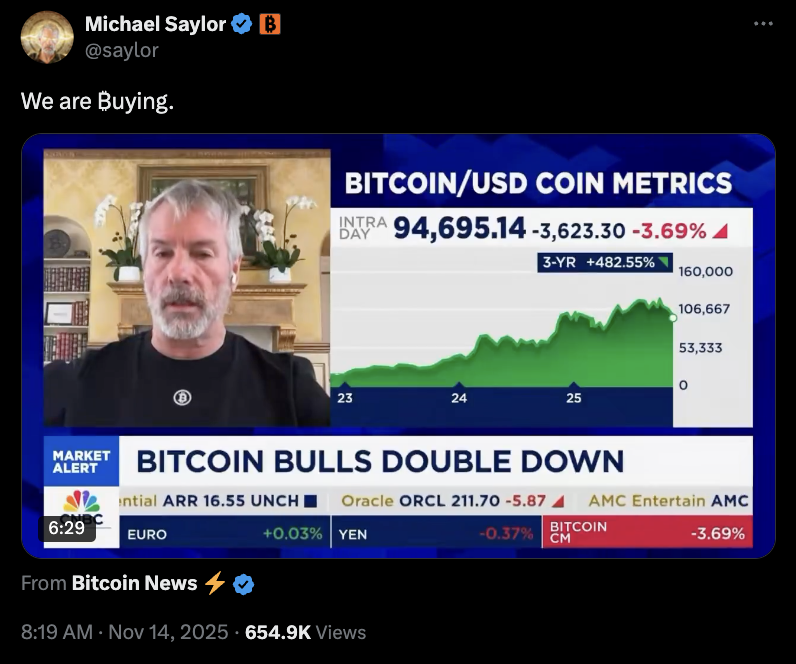MicroStrategy continues to bolster its Bitcoin holdings by purchasing more BTC amid a recent flash crash, with executive chair Michael Saylor confirming the strategy despite price volatility dropping below $95,000. This approach maintains their position as the largest corporate BTC holder with approximately 640,000 coins.
-
Michael Saylor denies reports of selling Bitcoin, affirming ongoing purchases during the price dip.
-
The flash crash saw Bitcoin fall over 4% in under 24 hours, from above $100,000 to under $95,000.
-
MicroStrategy holds about 640,000 BTC, though its market dominance is declining as competitors like Coinbase and Metaplanet increase their acquisitions.
MicroStrategy’s Bitcoin strategy shines amid crash: Saylor reveals continued buys boosting 640K holdings. Discover volatility insights and market impacts—stay ahead in crypto investments today.
What is MicroStrategy’s Bitcoin Strategy During Market Volatility?
MicroStrategy’s Bitcoin strategy involves aggressively accumulating BTC as a treasury reserve asset, even during sharp price declines. Executive chair Michael Saylor recently clarified that the company is not selling but actively buying more amid a flash crash that pushed Bitcoin below $95,000. This long-term approach, emphasizing a four-year investment horizon, positions MicroStrategy as a leader in corporate cryptocurrency adoption.

Source: Michael Saylor
How Has the Recent Bitcoin Flash Crash Affected MicroStrategy’s Holdings?
The recent Bitcoin flash crash, which saw the price drop more than 4% in less than 24 hours from over $100,000 to under $95,000, prompted unfounded reports suggesting MicroStrategy was offloading assets. Michael Saylor, in a statement on X (formerly Twitter), dismissed these claims, stating there was “no truth” to reports of reducing holdings by about 47,000 BTC, valued at roughly $4.6 billion at the time. Instead, MicroStrategy continued its accumulation, adding to its existing treasury of approximately 640,000 BTC.
During a CNBC interview on Friday, Saylor emphasized the inherent volatility of the cryptocurrency market. “I think the volatility comes with the territory,” he said. “If you’re going to be a Bitcoin investor, you need a four-year time horizon and you need to be prepared to handle the volatility in this market.” This perspective aligns with MicroStrategy’s overall philosophy of viewing Bitcoin as a superior store of value compared to traditional fiat currencies, a stance the company has maintained since initiating its BTC purchases in 2020.
Data from blockchain analytics firms like Nansen indicate that while MicroStrategy remains the largest corporate holder of Bitcoin, its relative dominance has waned. In October, cryptocurrency exchanges such as Coinbase and Japanese firm Metaplanet outpaced MicroStrategy in Bitcoin acquisitions, reflecting broader institutional interest in digital assets. Despite this, MicroStrategy’s holdings represent a significant portion of the circulating Bitcoin supply, underscoring its pivotal role in the ecosystem.
The company’s stock, traded as MSTR on Nasdaq, also experienced pressure from the market downturn. Shares fell to $205.38, marking a decline of more than 17% over the previous five trading days. Analysts attribute this to broader market sentiment rather than any fundamental shift in MicroStrategy’s Bitcoin-centric business model, which integrates BTC as a core balance sheet asset.
MicroStrategy’s unwavering commitment to Bitcoin accumulation during downturns exemplifies a contrarian investment approach in the volatile crypto space. By leveraging debt and equity offerings to fund purchases, the company has built what Saylor describes as a “digital gold” fortress. This strategy not only hedges against inflation but also capitalizes on Bitcoin’s historical tendency to recover from corrections, as evidenced by past cycles where prices rebounded significantly after flash crashes.
Regulatory experts, such as those from the Blockchain Association, note that corporate adoption like MicroStrategy’s could influence future U.S. policy on digital assets. Without linking to external reports, it’s clear from public filings that MicroStrategy’s transparency in quarterly disclosures builds investor confidence, even as market fluctuations test resolve.
Frequently Asked Questions
Is MicroStrategy Still Buying Bitcoin After the Recent Price Crash?
Yes, MicroStrategy is actively purchasing Bitcoin following the flash crash. Executive chair Michael Saylor confirmed via X that the company denied selling reports and continued acquisitions, adding to its 640,000 BTC holdings despite the price dipping below $95,000. This aligns with their long-term treasury strategy focused on volatility resilience.
What Impact Did the US Government Shutdown End Have on Bitcoin Prices?
The end of the 43-day US government shutdown brought initial optimism, pushing Bitcoin above $106,000 temporarily. However, upon reopening, prices fell below $100,000, as per Nansen data. This reflects Bitcoin’s sensitivity to macroeconomic events, though experts anticipate stabilization with ongoing institutional inflows.
Key Takeaways
- MicroStrategy’s Proactive Buying: The company refuted selling rumors and added to its Bitcoin stash during the crash, highlighting a steadfast accumulation policy.
- Volatility as a Feature: Saylor’s advice on embracing market swings with a multi-year horizon provides a blueprint for BTC investors navigating uncertainty.
- Shifting Market Dynamics: While MicroStrategy leads in holdings, rising competition from firms like Coinbase signals maturing corporate crypto adoption—consider diversifying exposure.
Conclusion
MicroStrategy’s Bitcoin strategy during the recent flash crash reaffirms its position as a trailblazer in corporate cryptocurrency integration, with Michael Saylor’s insights underscoring the value of patience amid volatility. As holdings near 640,000 BTC and competitors emerge, the broader impact on Bitcoin’s trajectory points to sustained growth. Investors should monitor regulatory developments and market sentiment for opportunities, ensuring a balanced approach to digital asset exposure in the evolving financial landscape.
Although the end of the 43-day US government shutdown spurred a brief rally in equities, Bitcoin’s response was mixed, surging past $106,000 on Sunday amid funding deal hopes before dropping below $100,000 upon Thursday’s reopening, according to Nansen analytics. The cryptocurrency’s price dynamics continue to intertwine with global events, yet MicroStrategy’s steady hand offers a model for enduring such fluctuations.
Related: Bitcoin ETFs bleed $866M in second-worst day on record, but some analysts still bullish.
Magazine: Big Questions: Did a time-traveling AI invent Bitcoin?






